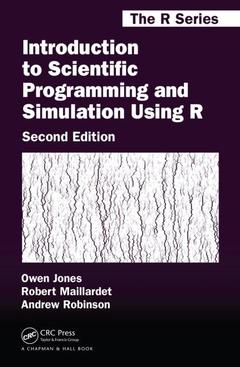Introduction to Scientific Programming and Simulation Using R (2nd Ed.) Chapman & Hall/CRC The R Series

Learn How to Program Stochastic Models
Highly recommended, the best-selling first edition of Introduction to Scientific Programming and Simulation Using R was lauded as an excellent, easy-to-read introduction with extensive examples and exercises. This second edition continues to introduce scientific programming and stochastic modelling in a clear, practical, and thorough way. Readers learn programming by experimenting with the provided R code and data.
The book?s four parts teach:
- Core knowledge of R and programming concepts
- How to think about mathematics from a numerical point of view, including the application of these concepts to root finding, numerical integration, and optimisation
- Essentials of probability, random variables, and expectation required to understand simulation
- Stochastic modelling and simulation, including random number generation and Monte Carlo integration
In a new chapter on systems of ordinary differential equations (ODEs), the authors cover the Euler, midpoint, and fourth-order Runge-Kutta (RK4) schemes for solving systems of first-order ODEs. They compare the numerical efficiency of the different schemes experimentally and show how to improve the RK4 scheme by using an adaptive step size.
Another new chapter focuses on both discrete- and continuous-time Markov chains. It describes transition and rate matrices, classification of states, limiting behaviour, Kolmogorov forward and backward equations, finite absorbing chains, and expected hitting times. It also presents methods for simulating discrete- and continuous-time chains as well as techniques for defining the state space, including lumping states and supplementary variables.
Building readers? statistical intuition, Introduction to Scientific Programming and Simulation Using R, Second Edition shows how to turn algorithms into code. It is designed for those who want to make tools, not just use them. The code and data are available for download from CRAN.
Programming. Numerical Techniques. Probability and Statistics. Simulation. Glossary of R Commands. Programs and Functions Developed in the Text. Index.
Date de parution : 08-2014
Ouvrage de 582 p.
15.6x23.4 cm
Thèmes d’Introduction to Scientific Programming and Simulation... :
Mots-clés :
Transition Rate Diagram; Cumulative Distribution Function; solving systems of ordinary differential equations; FALSE FALSE; Program Stochastic Models; Ordinary Differential Equations; scientific programming and stochastic modelling; Antithetic Variates; learn programming by experimenting with the R code; Discrete Time Markov Chain; mathematics from a numerical point of view; FALSE TRUE FALSE FALSE FALSE; root finding; numerical integration; and optimisation; Continuous Time Markov Chain; random number generation and Monte Carlo integration; RK4 Scheme; simulating discrete- and continuous-time chains; Grand Fir; Markov chains; Program spuRs; Build statistical intuition; Fixed Point Method; Discrete Random Variables; Monte Carlo Integration; Simpson’s Rule; Iid Sample; User Defined Functions; Continuous Time; Transition Matrix; State Transition Diagram; Markov Chain; Midpoint Scheme; Adaptive Quadrature; Rosenbrock Function; Importance Sampling



